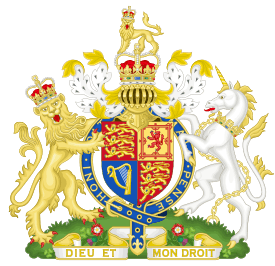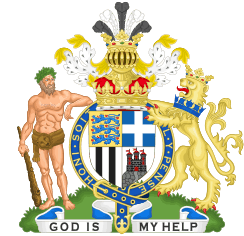Holland & Holland
 | |
| Private | |
| Industry | Gun manufacturer |
| Founded | London, England 1835 |
| Founder | Harris Holland |
| Headquarters | London, England, United Kingdom |
Number of locations | 4 stores |
Area served | London, New York City, Middlesex, Moscow |
| Products | Rifles, Clothing, Accessories, operator of shooting estates [1] |
Number of employees | 101 - 250[2] |
| Website |
www |
Holland & Holland is a British gun-maker based in London, England which offers handmade sporting rifles and shotguns. The company holds two Royal Warrants.
History
Holland & Holland was founded by Harris Holland (1806–1896) in 1835.[3]
At first, the guns bore the inscription H.Holland, without an address, and it is probable that these were built in the trade to his design. It is not known when Harris Holland started his own manufacturing, but it is estimated to be in the 1850s. This start makes him very unusual among the London Best makers, as others such as Purdey, Boss, Lang and Lancaster had apprenticed with Joseph Manton, while others such as Beesley, Grant and Atkin apprenticed with Purdey or Boss.[3]
In 1883, Holland & Holland entered the trials organized by the magazine The Field and won all of the rifle categories. This set a new standard of excellence for the competition among English gunmakers. In 1885, patents were granted to Holland & Holland for their Paradox gun, a shotgun with rifling in the front two inches of the barrel.[4]
In 1908, they patented the detachable lock feature with small lever, for sidelock shotguns. The last major development in the evolution of the sidelock side-by-side gun occurred in 1922, when the H&H assisted-opening mechanism was patented. This gun, the self-opening Royal side-by-side, has been hugely influential in gun-making throughout the world.[4]
In the period after World War II under the leadership of new owner and Managing Director Malcolm Lyell, the company made sorties to India, where guns from the famous collections of the princes and maharajahs were bought back, developing an important market for second-hand pieces. In 1989, all remaining shares in H&H were bought by the French cosmetics group Chanel. Since then, the factory building, in use since 1898, has been extensively renovated and equipped with modern technology. Guns such as the Royal Over & Under or side-by-side double-barreled shotguns were improved and reintroduced, and they are available from 4 bore to .360 inch. A hand-built gun from H&H can cost around £60,000 for a shotgun and close to £100,000 for some rifles, with prices roughly doubling with luxury engraving, and there is a waiting period of 2–3 years between ordering and delivery.[5]
During the Second World War, Holland & Holland, along with a few other select companies, fitted the scopes to the Lee Enfield No.4T sniper rifle.
In the 1990s, Holland & Holland started on a major program of expansion. The company has gunrooms in New York City and Moscow. The company's London flagship store on Bruton Street has been completely renovated and expanded.[5]
Harris Holland

Harris Holland was born in 1806 in London. Although accounts of his background are somewhat sketchy, it is believed that his father was an organ builder, while Harris had a tobacco wholesale business in London. Obviously he was successful, as he was often seen at various pigeon shoots at important London clubs, as well as leasing a grouse moor in Yorkshire.[3]
Having no children of his own, he took on his nephew Henry Holland as an apprentice in 1861. In 1867 Henry became a partner and in 1876 the name changed to Holland & Holland. Although Henry was a full partner, Harris kept strict control and was the only one who could sign a cheque until he died in 1896.[3]
Calibres
Holland & Holland has created some very well known calibres. Their entire line of cartridges has been developed with hunting in mind and has been associated romantically with the last part of the golden age of safaris and dangerous game hunting.
These calibres are:
- .297/250 Rook: a black powder round that fires a 56 grain lead bullet
- .295 (.300) Rook: a black powder round that fires a 120 grain lead bullet
- .240 Apex: introduced 1920, known also as .240 Belted Nitro Express and the .240 Magnum Rimless. Used for deer and plains game with a .245 bullet weighing 100 grains
- .240 Flanged Nitro Express: a variation of the .240 Apex created for the safari double rifles and intended for medium size game.
- .244 H&H Magnum: introduced 1955, as a cartridge suitable for long range deer hunting in Scottish Highlands. Based on the extremely successful .375 H&H but with .245 bullet with a weight of 100 grains
- .275 H&H Belted Magnum: introduced in 1912 and based on the 375 H&H case shortened to 2.5" with a 7 mm 140–175 grain bullet. This cartridge was the inspiration for a number of 7 mm Magnum designs from other manufacturers and originally used cordite as propellant powder. The flanged version of this cartridge was known as the 7mm H&H flanged.
- .300 H&H Magnum: second most popular calibre invented by Holland & Holland, was introduced in 1925. It is meant to tackle large plains game, particularly African like zebra, giraffes or heavy antelopes but also a favourite of North American moose and elk hunters. While not as popular, it is fairly similar to .300 Winchester Magnum over which the .300 H&H Magnum may have an advantage when loaded with bullets of 220 grains or heavier. The first .300 H&H Magnum rifle recorded in the Holland & Holland Number Books was serial number 30494, tested on 1 October 1926.[6] When the .300 H&H Magnum was introduced it was branded as the "Super-Thirty"[7]
- .30 "Super" Flanged or .300 H&H Flanged: a flanged version of the .300 H&H Magnum cartridge for use in breech loading and double rifles. It has almost the same specifications, and nearly the same performance, as the .300 H&H Magnum.
- .400/375 Belted Nitro Express: introduced in 1905.
- .375 H&H Magnum or 375 H&H: the most popular calibre invented by Holland & Holland, and was introduced in 1912 as a Nitro Express cartridge using cordite, but worked its way into becoming also the world's most popular safari calibre to date, due to its versatility. Bullet has a 9.5 mm diameter, and weighs between 235 and 300 grains (15.2 and 19.4 g). While a medium-bore cartridge that some consider too big for medium game and too small for big or dangerous game, the .375 H&H has nonetheless become the official minimum cartridge for hunting dangerous game throughout much of Africa. While big by modern standards, it remains a popular cartridge for Canadian and Alaskan bears, seeing heavy use by outfitters and professional hunters.
- .375 Flanged Nitro Express: a cartridge for use in breech-loading and double rifles and therefore popular in Africa, but in the past was considered an effective tiger cartridge. It has almost the same specifications as the .375 H&H Magnum.
- .400 H&H Magnum: a recent cartridge introduced in 2003, based on the .375 H&H Magnum case and using a 400 grain bullet at 2,300 feet per second. The .400 H&H Magnum is designed for use in bolt action rifles and to carry the muzzle energy of the .375 H&H Magnum out 100 yards.[8]
- .465 H&H Magnum: introduced in 2003, is a modern big-bore cartridge from Holland & Holland based on the 460 Weatherby case. This cartridge was created to be used for big- or dangerous-game hunting, following the safari tradition of the brand. The .465 H&H Magnum is designed for use in bolt-action rifles and to carry the muzzle energy of the .375 H&H Magnum out 200 yards and, in so doing, carries the muzzle energy of the .400 H&H Magnum out 100 yards.[8]
- .500/450 Nitro Express: created in the late 1890s, using the .500 Black Powder Express case necked down to emulate the .450 Nitro Express performance with lower chamber pressure and slightly higher velocity. Due to its low pressure and considerable power, it was used almost exclusively to hunt dangerous game in the tropical colonies of the former British Empire, like East Africa or India.
- .500/465 Nitro Express: a development of the .500/450 Nitro Express when the .45 calibre was banned from Sudan and India in 1907 by the British Government. It is essentially the older cartridge necked up to accept a larger-calibre bullet, and delivers the same level of performance. For many years it was the most common chambering for heavy double rifles after the .470 Nitro Express, and it continues to be the standard caliber for H&H doubles.
- .577 Nitro Express: the standard caliber of professional ivory hunters in the 19th and early 20th centuries.
- .600/577 REWA:
- .700 Nitro Express: developed in 1988, essentially a scaled-up .600 Nitro Express
- 12 bore Paradox. A massive 740-grain lead bullet. Originally it was available in the large 4, 8, and 10 bores along with 12, 16, 20, and 28 bores.
- 12 bore Aero Gun. A smoothbore gun using chain shot used to damage the structure of Zeppelins.
- 12 bore & .410. A single barrel gun used for the marking of whales.
List of clients
Holland & Holland is regarded as a luxury sporting gunmaker, enjoying a reputation in the world similar to other British-made luxury brands such as Bentley or Rolls-Royce. Together with James Purdey and Sons, regarded as their primary competitor, they are the only gunmakers to hold a British Royal Warrant. Their clientele, since the 19th century, have included famous explorers, such as Frederick Courteney Selous, and royalty such as Prince Charles and the Duke of Edinburgh.
See also
- Schultz & Larsen
- Overfinch (luxury car maker)
References
- ↑ Holland & Holland was the lessee of the Molland shoot between 1998 and 2005
- ↑ Archived 26 April 2009 at the Wayback Machine.
- 1 2 3 4 "Our History | Holland & Holland". Hollandandholland.com. 2014-06-20. Retrieved 2015-03-18.
- 1 2 "Our History | Holland & Holland". Hollandandholland.com. 2014-06-20. Retrieved 2015-03-18.
- 1 2 "Our History | Holland & Holland". Hollandandholland.com. 2014-06-20. Retrieved 2015-03-18.
- ↑ Dallas, Donald (2003, Holland & Holland "The Royal" Gunmaker, p. 148–149. ISBN 1-57157-314-3.
- ↑ Dallas, Donald (2003, Holland & Holland 'The Royal' Gunmaker, Appendix 6. ISBN 1-57157-314-3.
- 1 2 Van Der Walt, Pierre, "Holland's Latest Cartridges" in Rowland Ward Field Sportsman, October 2008

.svg.png)

